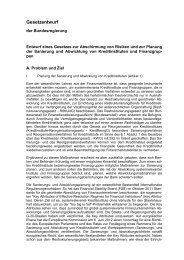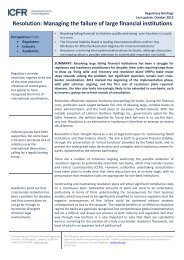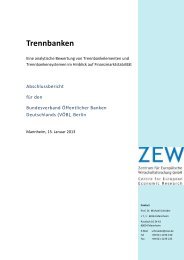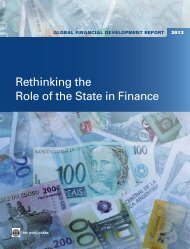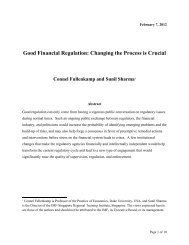3 Issuing costs of state guaranteed bonds - Financial Risk and ...
3 Issuing costs of state guaranteed bonds - Financial Risk and ...
3 Issuing costs of state guaranteed bonds - Financial Risk and ...
Create successful ePaper yourself
Turn your PDF publications into a flip-book with our unique Google optimized e-Paper software.
4 Impact <strong>of</strong> <strong>state</strong> <strong>guaranteed</strong> <strong>bonds</strong> on bank lending, funding <strong>and</strong> pr<strong>of</strong>itability performance<br />
Firstly, for participating banks, the difference in bank outcomes is considered pre- <strong>and</strong> postparticipation.<br />
For instance, Swedbank AB received <strong>state</strong> guarantees over 2008 <strong>and</strong> 2009. In 2007,<br />
pre-participation, it extended €129m <strong>of</strong> credit based in net loans. And in 2010, post-participation,<br />
it extended €133m <strong>of</strong> credit. Therefore, the difference in credit extension for Swedbank was €4m.<br />
Secondly, for non-participating banks, the difference in banks outcomes is considered over the<br />
same time period as for participating banks. For example, for apoBank AG, the difference in net<br />
loans between 2008 <strong>and</strong> 2010 was €0.33m.<br />
Finally, the difference-in-differences <strong>of</strong> net loans for participating <strong>and</strong> non-participating banks are<br />
compared. For Swedbank AB <strong>and</strong> apoBank AG, their difference-in-differences <strong>of</strong> net loans was<br />
€3.67m.<br />
The benefit <strong>of</strong> the difference-in-differences approach is that many unobservable <strong>and</strong>/or nonmeasurable<br />
differences that affect participating <strong>and</strong> non-participating bank outcomes are<br />
controlled for.<br />
Differences in bank characteristics that affect bank outcomes are taken into account through<br />
considering differences in bank outcomes over time. For instance, size, e.g., in terms <strong>of</strong> a strong<br />
local deposit base, may explain a large proportion <strong>of</strong> the difference in the level <strong>of</strong> credit (i.e., the<br />
stock <strong>of</strong> loans) extended by Swedbank AB <strong>and</strong> apoBank AG. However, it is unlikely to explain much<br />
<strong>of</strong> the change in credit extension undertaken by Swedbank AB <strong>and</strong> apoBank AG over 2008 <strong>and</strong><br />
2010. 18<br />
Additionally, by considering participating <strong>and</strong> non-participating banks over the same time period,<br />
economic conditions affecting both groups equally are accounted for. For instance, the banking<br />
sector may have experienced a post-financial crisis recovery in 2010 leading to improved bank<br />
outcomes for all banks. Continuing with the example <strong>of</strong> Swedbank AB <strong>and</strong> apoBank AG, net loans<br />
may have grown by an average <strong>of</strong> €0.2m for both banks due to the recovery effect. Given other<br />
determinants <strong>of</strong> bank outcomes that are observed <strong>and</strong> can be measured, which may amount to<br />
€3m, the outst<strong>and</strong>ing difference-in-differences <strong>of</strong> €0.67m (€4m - €3m - €0.33m) can therefore be<br />
viewed as the average impact <strong>of</strong> a <strong>state</strong> guarantee on bank outcomes in our sample <strong>of</strong> 2 banks.<br />
The outst<strong>and</strong>ing concern regarding the difference-in-differences approach is the impact <strong>of</strong> timevarying<br />
factors on the difference-in-differences <strong>of</strong> bank outcomes. For instance, in terms <strong>of</strong> our<br />
example above, if Swedbank AB grew more than apoBank AG over the period 2008-2010 then part<br />
<strong>of</strong> the €0.67m difference-in-differences in net loans would be due to this change in relative size<br />
instead <strong>of</strong> use/non-use <strong>of</strong> <strong>state</strong> guarantees. To account for changes in size, the main difference-indifferences<br />
results are re-estimated with interactions between independent variables <strong>and</strong> bank<br />
outcome variables.<br />
Finally, the limitation <strong>of</strong> the difference-in-differences approach is the impact <strong>of</strong> time-varying<br />
factors that influence difference-in-differences <strong>of</strong> bank outcomes that are unobserved or<br />
unaccounted for.<br />
18 Moreover, to account for size explicitly, we also consider difference-in-differences in percentage terms. That is, a €4m expansion in<br />
credit extension for Swedbank AB represents a 3.1% increase <strong>and</strong> a €0.33m expansion in credit extension for apoBank AG<br />
represents a 1.4% increase, <strong>and</strong> therefore a difference-in-differences <strong>of</strong> 1.7%.<br />
94



